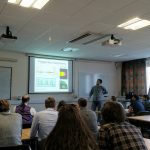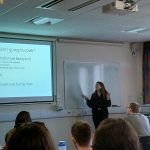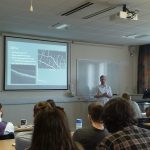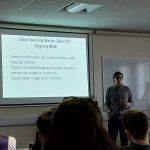Quantitative Phase Microscopy using Fibre Optic Bundles
Grace Maxted (supervised by Dr Mike Hughes)
Phase imaging is a method of imaging which typically utilises an interferometer to obtain quantitative measures of properties, such as the refractive index or optical thickness, of a material. In this project the aim was to determine the feasibility of combining phase imaging with a fibre optic bundle as, among other factors, the differing length of the individual cores along with the spaces between cores within the bundle may present significant difficulties. The applications of this optical system, if feasible, would be in (endo)microscopy.
Gabor Scanning Master-Slave Optical Coherence Tomography
(Towards rapid skin cancer diagnosis)
Josh Edwards (supervised by Dr Adrian Bradu)
The development of non-invasive optical biopsy techniques holds promise for improving both the speed of diagnosis and treatment outcomes of skin cancers over traditional surgical biopsies.
To this end, the use of master-slave optical coherence tomography to generate 3d volumes in-vivo is discussed along with the benefits (long axial range) and limitations (low lateral resolution) that this brings.
To reduce the effect of these limitations, a method of refocusing (Gabor Scanning) using a translatable beam collimation lens in the sample arm has been tested. Yielding a system capable of an axial range of 800μm, minimum confocal profile (lens limited) of 15μm, and an OCT resolution (source limited) of 25μm stable over a 4 mm axial range.
2d images and 3d projections have been generated showing the benefits of the Gabor Scanning technique and the practical ability to resolve cellular structures which is key to the stated purpose of optical biopsy.
Image Registration & Segmentation in OCT-A
Alex Poppe (supervised by Dr Stuart Gibson)
A brief background will be given regarding the functionality of optical coherence tomography (OCT) and its extension; OCT angiography (OCT-A) in the field of medical imaging. This talk will focus on the image processing techniques implemented to manipulative any given 3D data set, which are comprised of multiple 2D retina scans, called B-scans. These processing techniques are: Image registration for image alignment using Fourier transform algorithms; image segmentation for identification of individual retina layers inside B-scans using edge detection, and structure-preserving smoothing filters; in addition image interpolation is used to correct for mistakes in edge detection. The software developed in this project has generated an En-face image and a 3D model which have practical medical applications, namely clinical diagnosis of eye diseases such as macular holes, diabetic retinopathy, and Alzheimer’s disease.
Accuracy in Measurements of Path Differences Using Spectral Domain Interferometry
Stella Frift (supervised by Prof Adrian Podoleanu and Dr Adrian Bradu)
Optical Coherence Tomography is a non-invasive imaging modality that utilises the coherent property of light to produce high resolution images of biological tissue. Images produced by this technique of the retinal layers, the light sensitive tissue located at the back of the eye can be studied by a clinician. By observing deterioration or differences in these layers when compared to a healthy eye, a diagnosis can made and the relevant medical care delivered to the patient. The position that a particular layer is located at is represented by an Optical Path Difference. Directly related to this is the thickness of each layer. It it therefore vitally important that these path differences are as accurate as possible to prevent misdiagnosis. This presentation will detail an investigation into the accuracy of path differences when using a novel imaging technique developed by the Applied Optics Group at the University of Kent, known as Complex Master-Slave Interferometry. The effect that different numbers of Experimental Spectra collected during the Master stage of this method has on these values was evaluated and it was determined that four experimentally collected values could be used with only a small reduction in accuracy when compared to larger data sets.
Optimisation of a Polygon Mirror Swept Source
Harry Batty (supervised by Dr George Dobre)
This project aimed to optimise a current swept-source input that utilises a polygon mirror. This swept source would be used as part of a larger optical coherence tomography (OCT) setup, to image biological samples. The simulation was done using Zemax™ . The use of a reflective telescope that implemented two parabolic mirrors was investigated as an option to replace the lens telescope, as it would support a much greater bandwidth. A comparison was made between versions of the system at key points, which showed that the mirror setup supports marginal wavelengths better than the lens and secondly, the orientation of the paraboloids had a significant effect.



